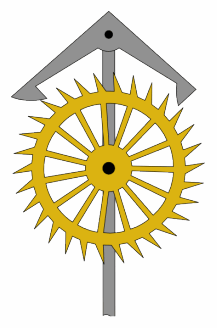English: Animation of an anchor escapement used in pendulum clocks. An escapement is a mechanism in a clock which gives the pendulum pushes to keep it swinging, and at each swing releases the gear train to move forward a fixed amount, thus moving the clock's hands forward at a steady rate. The recoil or anchor escapement, invented by Robert Hooke around 1658 and first applied to clocks around 1680, was the standard escapement used in pendulum clocks until the late 1800s, when a more accurate variation called the deadbeat escapement superseded it. It consists of an "escape wheel" (yellow) which is driven by the clock's gear train. The pivoted "anchor" piece above it (grey) is attached to the clock's pendulum (not shown) which hangs below it. The anchor has flat angled surfaces on each side called "pallets" which the escape wheel's teeth alternately catch and push on, giving the pendulum impulses to replace the energy it loses to friction, keeping it swinging.
This animation shows a typical anchor escapement found in a grandfather clock. The clock has a seconds pendulum, with a period of 2 seconds, so each swing takes one second. The escape wheel has 30 teeth and thus rotates once per minute, so the clock's second hand can be attached to its shaft. The amplitude or width of swing of the pendulum in this example is about 8°, a little wider than many quality anchor clocks, which have amplitudes of 3° - 6°. Of this angle, the "lift" or "drive" angle, the angle of forward swing over which the pendulum receives drive force, is 5°, while the remaining 3° consists of the "recoil".
The animation illustrates one of the disadvantages of the anchor: "recoil", which means the pendulum pushes the escape wheel backwards during part of each cycle. Recoil reverses the clock's gear train all the way back to the driving weight each swing of the pendulum, causing increased wear and inaccuracy.
Français : Schéma animé d'un "recul" ou échappement à ancre utilisée dans pendules, inventé par Robert Hooke en 1657
Русский: Анимированные диаграммы из отдачи или анкерного спуска, используемого в маятниковых часов
Deutsch: Animierte Grafik eines Rückstoß oder Ankerhemmung in Pendeluhren verwendet wird, von Robert Hooke im Jahre 1657 erfunden.
Italiano: Diagramma animato di un "contraccolpo" o scappamento ad ancora utilizzati in orologi a pendolo, inventato da Robert Hooke nel 1657
Dansk: Diagramma animato di un "contraccolpo" o scappamento ad ancora utilizzati in orologi a pendolo, inventato da Robert Hooke nel 1657
Nederlands: Geanimeerde diagram van een "terugslag" of ankergang gebruikt in slingerklokken, uitgevonden door Robert Hooke in 1657
Español: Diagrama animado de un "retroceso" o escape de áncora utilizado en relojes de péndulo, inventado por Robert Hooke en 1657 |



